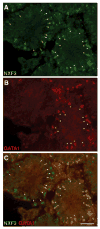Nxf3 is expressed in Sertoli cells, but is dispensable for spermatogenesis
- PMID: 21308854
- PMCID: PMC3081378
- DOI: 10.1002/mrd.21291
Nxf3 is expressed in Sertoli cells, but is dispensable for spermatogenesis
Abstract
In eukaryotes, mRNA is actively exported to the cytoplasm by a family of nuclear RNA export factors (NXF). Four Nxf genes have been identified in the mouse: Nxf1, Nxf2, Nxf3, and Nxf7. Inactivation of Nxf2, a germ cell-specific gene, causes defects in spermatogenesis. Here we report that Nxf3 is expressed exclusively in Sertoli cells of the postnatal testis, in a developmentally regulated manner. Expression of Nxf3 coincides with the cessation of Sertoli cell proliferation and the beginning of their differentiation. Continued expression of Nxf3 in mature Sertoli cells of the adult is spermatogenesis stage-independent. Nxf3 is not essential for spermatogenesis, however, suggesting functional redundancy among Nxf family members. With its unique expression pattern in the testis, the promoter of Nxf3 can be used to drive postnatal Sertoli cell-specific expression of other proteins such as Cre recombinase.
Copyright © 2011 Wiley-Liss, Inc.
Figures





Similar articles
-
Inactivation of Nxf2 causes defects in male meiosis and age-dependent depletion of spermatogonia.Dev Biol. 2009 Jun 1;330(1):167-74. doi: 10.1016/j.ydbio.2009.03.022. Epub 2009 Apr 1. Dev Biol. 2009. PMID: 19345203 Free PMC article.
-
Nuclear export factor 3 is involved in regulating the expression of TGF-β3 in an mRNA export activity-independent manner in mouse Sertoli cells.Biochem J. 2013 May 15;452(1):67-78. doi: 10.1042/BJ20121006. Biochem J. 2013. PMID: 23438076
-
Molecular cloning and functional characterization of mouse Nxf family gene products.Genomics. 2005 May;85(5):641-53. doi: 10.1016/j.ygeno.2005.01.003. Genomics. 2005. PMID: 15820316
-
Nociceptin and meiosis during spermatogenesis in postnatal testes.Vitam Horm. 2015;97:167-86. doi: 10.1016/bs.vh.2014.10.003. Epub 2015 Jan 14. Vitam Horm. 2015. PMID: 25677772 Review.
-
50 years of spermatogenesis: Sertoli cells and their interactions with germ cells.Biol Reprod. 2018 Jul 1;99(1):87-100. doi: 10.1093/biolre/ioy027. Biol Reprod. 2018. PMID: 29462262 Free PMC article. Review.
Cited by
-
Cytoplasmic localization of SBR (Dm NXF1) protein and its zonal distribution in the ganglia of Drosophila melanogaster larvae.Invert Neurosci. 2016 Sep;16(3):9. doi: 10.1007/s10158-016-0192-5. Epub 2016 Jul 7. Invert Neurosci. 2016. PMID: 27389771
-
Respiratory failure, cleft palate and epilepsy in the mouse model of human Xq22.1 deletion syndrome.Hum Mol Genet. 2014 Jul 15;23(14):3823-9. doi: 10.1093/hmg/ddu095. Epub 2014 Feb 25. Hum Mol Genet. 2014. PMID: 24569167 Free PMC article.
-
A 1.1-Mb segmental deletion on the X chromosome causes meiotic failure in male mice.Biol Reprod. 2013 Jun 27;88(6):159. doi: 10.1095/biolreprod.112.106963. Print 2013 Jun. Biol Reprod. 2013. PMID: 23677977 Free PMC article.
-
Evolutionarily diverged regulation of X-chromosomal genes as a primal event in mouse reproductive isolation.PLoS Genet. 2014 Apr 17;10(4):e1004301. doi: 10.1371/journal.pgen.1004301. eCollection 2014 Apr. PLoS Genet. 2014. PMID: 24743563 Free PMC article.
-
Generation and characterization of an Nxf7 knockout mouse to study NXF5 deficiency in a patient with intellectual disability.PLoS One. 2013 May 13;8(5):e64144. doi: 10.1371/journal.pone.0064144. Print 2013. PLoS One. 2013. PMID: 23675524 Free PMC article.
References
-
- Berger UV, Hediger MA. Differential distribution of the glutamate transporters GLT-1 and GLAST in tanycytes of the third ventricle. J Comp Neurol. 2001;433:101–114. - PubMed
-
- Charron M, Folmer JS, Wright WW. A 3-kilobase region derived from the rat cathepsin L gene directs in vivo expression of a reporter gene in sertoli cells in a manner comparable to that of the endogenous gene. Biol Reprod. 2003;68:1641–1648. - PubMed
-
- De Gendt K, Swinnen JV, Saunders PT, Schoonjans L, Dewerchin M, Devos A, Tan K, Atanassova N, Claessens F, Lecureuil C, Heyns W, Carmeliet P, Guillou F, Sharpe RM, Verhoeven G. A sertoli cell-selective knockout of the androgen receptor causes spermatogenic arrest in meiosis. Proc Natl Acad Sci U S A. 2004;101:1327–1332. - PMC - PubMed
Publication types
MeSH terms
Substances
Grants and funding
LinkOut - more resources
Full Text Sources
Molecular Biology Databases

